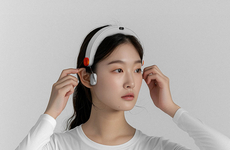
The ViXion Mixed-Reality Headset Supports Those with Blindness
Michael Hemsworth — September 1, 2021 — Tech
References: nendo.jp & yankodesign
The ViXion mixed-reality headset has been created in partnership with Nendo as an advanced wearable for those with reduced visibility or those who are legally blind to offer support as they traverse the city. The headset works by being worn over the eyes in a visor-like manner and utilizes a camera mounted on the front to capture footage of what's ahead of the wearer. This footage is then processed to increase visibility to suit those with low vision, night blindness or low periphery vision by brightening content, allowing for black and white inversion and more.
The ViXion mixed-reality headset maintains a comfort-focused design given the long periods it's meant to be worn for and is outfitted with HOYA optics to allow for corrective lens to be incorporated in.
Image Credit: Nendo
The ViXion mixed-reality headset maintains a comfort-focused design given the long periods it's meant to be worn for and is outfitted with HOYA optics to allow for corrective lens to be incorporated in.
Image Credit: Nendo
Trend Themes
1. Mixed-reality Headsets for Visually Impaired - Developing advanced mixed-reality headsets customized for those with reduced visibility or who are legally blind represents a significant disruptive innovation opportunity.
2. Artificial Intelligence for Image Recognition - Incorporating AI algorithms into image processing to improve vision enhancement for those with low vision, night blindness, or low periphery vision is a compelling disruptive innovation opportunity.
3. Wearable Technology for Medical Conditions - Designing wearable technology to improve the quality of life for those with medical conditions, particularly those with limited mobility and sensory limitations, is a promising disruptive innovation opportunity.
Industry Implications
1. Healthcare Technology - The healthcare technology industry can leverage mixed-reality headsets and AI image recognition to improve medical treatment for patients with visual impairment.
2. Wearable Technology - The Wearable Technology industry can incorporate HOYA optics and create comfortable mixed-reality headsets designed for medical conditions associated with sensory limitations.
3. Assistive Technology - Assistive technology companies should focus on creating innovative products such as mixed-reality headsets and AI algorithms that cater to the needs of differently-abled people to improve their quality of life.
2.6
Score
Popularity
Activity
Freshness























